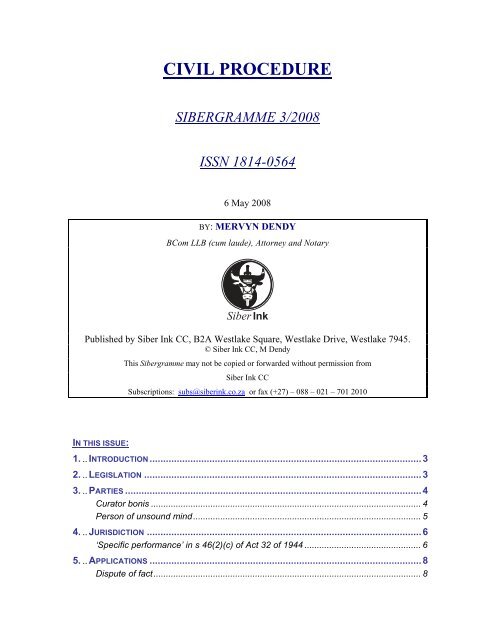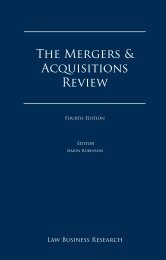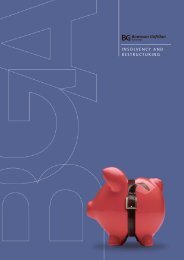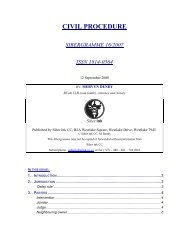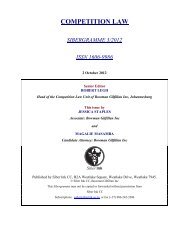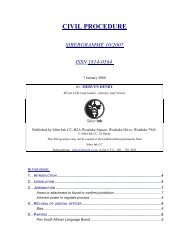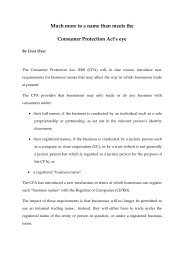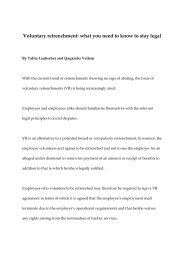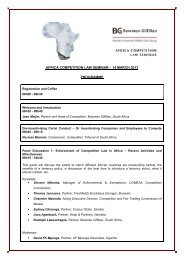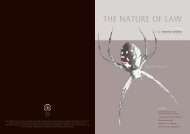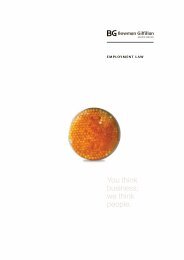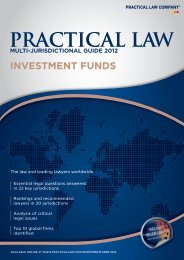SIBERGRAMMES 1 - Bowman Gilfillan Attorneys
SIBERGRAMMES 1 - Bowman Gilfillan Attorneys
SIBERGRAMMES 1 - Bowman Gilfillan Attorneys
- No tags were found...
Create successful ePaper yourself
Turn your PDF publications into a flip-book with our unique Google optimized e-Paper software.
CIVIL PROCEDURESIBERGRAMME 3/2008ISSN 1814-05646 May 2008BY: MERVYN DENDYBCom LLB (cum laude), Attorney and NotarySiber InkPublished by Siber Ink CC, B2A Westlake Square, Westlake Drive, Westlake 7945.© Siber Ink CC, M DendyThis Sibergramme may not be copied or forwarded without permission fromSiber Ink CCSubscriptions: subs@siberink.co.za or fax (+27) – 088 – 021 – 701 2010IN THIS ISSUE:1. .. INTRODUCTION ....................................................................................................32. .. LEGISLATION ......................................................................................................33. .. PARTIES .............................................................................................................4Curator bonis ............................................................................................................. 4Person of unsound mind............................................................................................ 54. .. JURISDICTION .....................................................................................................6‘Specific performance’ in s 46(2)(c) of Act 32 of 1944 ............................................... 65. .. APPLICATIONS ....................................................................................................8Dispute of fact............................................................................................................ 8
Page 2 ISSN 1814 – 0564 CIVIL PROCEDURE SG 3/20086. .. TRIAL ACTIONS....................................................................................................8Amendment of pleadings ........................................................................................... 8Exception ................................................................................................................... 97. .. RES JUDICATA ....................................................................................................108. .. INTERDICTS.........................................................................................................11Final interdict ............................................................................................................. 119. .. JUDGMENTS AND ORDERS....................................................................................11Anton Piller ................................................................................................................ 11Rule 43 order ............................................................................................................. 1110. APPEALS............................................................................................................11Appealability .............................................................................................................. 11Application for leave to appeal................................................................................... 13Equality court ............................................................................................................. 13Further evidence........................................................................................................ 1411. COSTS................................................................................................................14De bonis propriis........................................................................................................ 1412. CONSTITUTIONAL PRACTICE .................................................................................14Application for leave to appeal to Constitutional Court .............................................. 14Costs.......................................................................................................................... 15Direct appeal to Constitutional Court ......................................................................... 15Further evidence on appeal ....................................................................................... 15Jurisdiction of Constitutional Court ............................................................................ 16CasesHigh School Ermelo & another v The Head of Department & others [2008] 1 AllSA 139 (T) .................................................................................................................... 13Hopf v The Spar Group (Build It Division) & another 2008 (1) BCLR 72 (D)...... 13, 14Malkiewicz v Van Niekerk and Fourouclas Investments CC [2008] 1 All SA 57(T) ................................................................................................................................... 6Masetlha v The President of the Republic of South Africa & another 2008 (1)BCLR 1 (CC), 2008 (1) SA 566 .................................................................................. 15Minister of Safety and Security v Van Niekerk 2008 (1) SACR 56 (CC) ............... 14, 16Molefe v Regent Insurance Company (Pty) Ltd [2008] 1 All SA 158 (W).............. 10, 14S v Shaik & others 2008 (1) SACR 1 (CC)............................................................... 14, 15Spangenberg & another v De Waal [2008] 1 All SA 162 (T) ................................ 4, 5, 11The Trustees for the Time Being of the Bus Industry Restructuring Fund v BreakThrough Investments CC & others [2008] 1 All SA 23 (SCA).................................... 9Thekweni Properties v Picardi Hotels Ltd & another [2008] 1 All SA 172 (D)........ 8, 10Page 2 of 16 § Civil Procedure SG 3/2008© Siber Ink CC, M DendyThis Sibergramme may not be copied or forwarded without permission fromSiber Ink CC
Page 3 ISSN 1814 – 0564 CIVIL PROCEDURE SG 3/2008Traut v Fiorine & another 2008 (1) BCLR 84 (C)..................................................... 8, 11Trustees, Bus Industry Restructuring Fund v Break Through Investments CC& others 2008 (1) SA 67) ............................................................................................... 9Van Niekerk & another v Van Niekerk & another [2008] 1 All SA 96 (SCA), 2008(1) SA 76....................................................................................................................... 11LegislationTraditional Health Practitioners Act 22 of 2007 ........................................................... 3GN 47 GG 30680 of 25 January 2008 ............................................................................. 3GN 52 GG 30680 of 25 January 2008 ............................................................................. 3LiteratureNone1. INTRODUCTIONIn this Sibergramme cases on civil procedure published in the January 2008issues of The All South African Law Reports, Butterworths Constitutional LawReports and The South African Criminal Law Reports are considered.Legislation on civil procedure published in January 2008 is also considered.No literature of relevance to civil procedure was published during January 2008.Cases on civil procedure reported in the January 2008 issue of The South AfricanLaw Reports will be considered in Civil Procedure Sibergramme 4 of 2008.2. LEGISLATIONA right of appeal to the Interim Traditional Health Practitioners Council of South Africaagainst decisions of the registrar of the Council is created by s 27(1) of the TraditionalHealth Practitioners Act 22 of 2007, promulgated in GG 30660 of 10 January 2008. Aright of appeal to the High Court against a decision of the Council is created bys 27(2).A small claims court for the area of Naphuno was established by GN 47 GG 30680of 25 January 2008.A small claims court for the area of Sekhukhune was established by GN 52GG 30680 of 25 January 2008.Page 3 of 16 § Civil Procedure SG 3/2008© Siber Ink CC, M DendyThis Sibergramme may not be copied or forwarded without permission fromSiber Ink CC
Page 4 ISSN 1814 – 0564 CIVIL PROCEDURE SG 3/20083. PARTIESCurator bonisThe husband of the respondent in Spangenberg & another v De Waal [2008] 1 All SA162 (T) had sustained head injuries in a motor collision, for which he had receivedsubstantial damages. As a result of his injuries, the husband was declared by theWitwatersrand Local Division to be of unsound mind and incapable of managing hisaffairs. The second applicant had been appointed as curator bonis to him. Some yearslater, the husband relocated to the Western Cape in order to live his mother, and decidednot to return to the common home he shared with the respondent. He indicated that he nolonger wished to be married to the respondent, and that he intended to divorce her and tostay with his mother. No divorce action was, however, instituted, although therespondent, believing such an action to be imminent, applied for, and obtained by default,an order in terms of uniform rule 43 directing the second applicant to pay maintenance tothe respondent out of the husband’s assets, as well as a contribution towards therespondent’s costs in the proposed divorce proceedings. In an application by the secondapplicant and a curator ad litem who was appointed to represent the husband at theinstance of the second applicant, the question arose whether the curator bonis, in theperiod prior to the appointment of a curator ad litem, had the locus standi to institutedivorce proceedings on the husband’s behalf.After quoting extensively from the judgment in Ex parte AB 1910 TPD 1332, to theeffect that a curator bonis lacks locus standi to institute such proceedings,Conradie AJ held that the fact that fault is no longer a requirement for a divorce to begranted does not justify a deviation from the decision in AB and does not allow a curatorbonis to have locus standi in divorce proceedings. The curator bonis, if he were to havehad locus standi, would have alleged that the husband’s marriage with the respondent hadbroken down irretrievably. And it would most probably have been more difficult for thecurator to prove irretrievable breakdown of the marriage than it would have been to provefault as required formerly (sc before the coming into operation of the Divorce Act 70 of1979) (at 167h—i). More often than not, evidence of the irretrievable breakdown of amarriage was emotional rather than factual in nature. When a spouse stated that his or hermarriage had irretrievably broken down, he or she was making ‘a statement of the heart’rather than a statement of fact. While there were certainly facts like adultery and violencewhich could be proved in order to demonstrate that a marriage had broken downirretrievably, it was very difficult for an outsider to prove that an individual nolonger loved or respected his or her spouse. It was not possible for an outsider to beable to gauge whether a spouse was prepared to forgive his marriage partner despitewhatever offence his partner had committed. What appeared to be unforgivable for oneperson was tolerable for another, given his particular circumstances. The fabric that kepta marriage from breaking down was no doubt unique to every marriage (at 167i—168b).Even though marriage, as an institution, was today much more secular in nature than atthe time of AB’s case, and even though divorce was much more prevalent and certainlymore socially acceptable than then, the deep personal nature of marriage had not changed,Page 4 of 16 § Civil Procedure SG 3/2008© Siber Ink CC, M DendyThis Sibergramme may not be copied or forwarded without permission fromSiber Ink CC
Page 5 ISSN 1814 – 0564 CIVIL PROCEDURE SG 3/2008and it remained the most intimate of all human relationships recognized by law (at168b—c).The fact that fault no longer needed to be proved in divorce proceedings madethe decision to institute divorce proceedings rather more personal than less personalin nature. There was thus no reason to depart from the judgment in AB in so far as itfound that a curator bonis does not have locus standi to institute divorce proceedings onbehalf of a person declared to be of unsound mind. In the case before the court, it couldtherefore not be said that there was a pending or contemplated matrimonial action whichwas about to be instituted by the curator bonis (at 168c—e).Further on Spangenberg’s case, see under ‘Person of unsound mind’ immediatelybelow.Person of unsound mindIn Spangenberg & another v De Waal [2008] 1 All SA 162 (T) Conradie AJ gaveconsideration to the question whether a person who has been declared by a court to be ofunsound mind and incapable of managing his affairs is legally capable of institutingdivorce proceedings. After referring to Prinsloo’s Curators Bonis v Crafford andPrinsloo 1905 TS 669 at 673, Pienaar v Pienaar’s Curator 1930 OPD 171 at 174—5 andBoberg’s Law of Persons and the Family 2 ed (1999) by Belinda van Heerden et al 106,the court held that in order to ascertain whether a person (the husband inSpangenberg’s case) possessed the mental capacity to institute a matrimonial actionon his own behalf, it would not be enough simply to state that he was incapable ofdoing so because the court had declared him to be of unsound mind (at 169c—d). Thecourt which had declared the husband in Spangenberg to be of unsound mind and as suchincapable of managing his own affairs had (presumably) considered his mental capacityto handle his own financial affairs and not necessarily his ability to make unrelatedpersonal decisions (at 169e). The husband might have had the mental capacity to assessthe state of his own marriage and to make a decision in accordance with his assessment(at 169h). It was not impossible that his mental condition had by that stage (ten yearssince he had sustained head injuries in a motor collision, resulting in his being declared tobe of unsound mind) improved to the extent that he understood exactly what he intendedto do (at 169i). It was, however, difficult for the court to assess on the evidence before itwhether the husband, when informing the respondent (his wife) that he wanted to divorceher, had the mental ability to assess the state of his marriage or the ability to decidewhether he wanted to remain married (at 170b). The court could not determine withcertainty that the husband possessed the mental capacity to institute a matrimonial actionwithout the assistance of a curator ad litem at the time when an order in terms of uniformrule 43 for maintenance pendente lite, and for a contribution towards costs, was made bydefault in favour of the respondent pursuant to statements made by her husband to theeffect that he wanted to divorce her and live with his mother. In the absence of theappointment at that time of a curator ad litem, the husband could not be held to have beenabout to institute an action for divorce, and since his curator bonis had no locus standi toinstitute such an action (as to which, see under ‘Curator bonis’ immediately above), theorder in terms of rule 43 should be set aside: there was no matrimonial action pending, asPage 5 of 16 § Civil Procedure SG 3/2008© Siber Ink CC, M DendyThis Sibergramme may not be copied or forwarded without permission fromSiber Ink CC
Page 6 ISSN 1814 – 0564 CIVIL PROCEDURE SG 3/2008contemplated in rule 43(1)(b), since the respondent herself had made it clear that she hadno intention whatsoever of instituting divorce proceedings against her husband (at 170c—d, read with 165h—i and 171b—c).4. JURISDICTION‘Specific performance’ in s 46(2)(c) of Act 32 of 1944In Malkiewicz v Van Niekerk and Fourouclas Investments CC [2008] 1 All SA 57 (T)the respondents had each issued summons out of a magistrate’s court against theappellant, claiming an order directing the appellant to remove a boundary wall erected bythe appellant which allegedly encroached on one of the properties of the respondents. Theappellant had raised, in opposition to both claims, identical special pleas relating tojurisdiction, contending that the court had no jurisdiction because there were noalternative claims for damages. The special pleas were clearly based on s 46(2)(c) of theMagistrates’ Courts Act 32 of 1944, which provides as follows:‘A court shall have no jurisdiction in matters –(a) . . .;(b) . . .;(c) in which is sought specific performance without an alternative of payment ofdamages except in –(i) the rendering of an account in respect of which the claim does not exceedthe amount determined by the Minister from time to time by notice in theGazette;(ii) the delivery or transfer of property, movable or immovable, notexceeding in value the amount determined by the Minister from time totime by notice in the Gazette; and(iii) the delivery or transfer of property, movable or immovable, exceeding invalue the amount determined by the Minister from time to time by noticein the Gazette, where the consent of the parties has been obtained interms of section 45;(d) . . . .’The presiding magistrate dismissed the special pleas, holding that the claims were notclaims for the specific performance of a contractual obligation, that s 46 was notapplicable, and that the court could entertain the matter by virtue of s 30(1) of theMagistrates’ Courts Act (which empowers magistrates’ courts to grant interdicts) (at58h—j). The defendant appealed, contending that the respondents’ claims were claims forspecific performance without alternative claims for damages and that s 46(2)(c) precludedthe magistrate’s court from hearing both matters.Since the claims in Malkiewicz clearly did not fall within the ambit of any of the threeexceptional situations adumbrated in subparagraphs (i), (ii) and (iii) of s 46(2)(c), thevalidity or otherwise of the appellant’s special pleas turned on the proper meaning of theexpression ‘specific performance’ in that provision. If ‘specific performance’ meant nomore than ‘specific performance’ due in terms of a contract, then the claimsPage 6 of 16 § Civil Procedure SG 3/2008© Siber Ink CC, M DendyThis Sibergramme may not be copied or forwarded without permission fromSiber Ink CC
Page 10 ISSN 1814 – 0564 CIVIL PROCEDURE SG 3/2008proceedings requires the court to look at the allegations in the particulars of claim for thefacts of the matter, where exception is taken to those particulars of claim (para 4 at 25c(All SA), 69A (SA)). Where defendants have chosen the exception procedure instead ofhaving the matter decided after the hearing of evidence at a trial, they have to show thatthe claim is (not may be) bad in law. Accordingly, where the dispute centres aroundthe correct interpretation of a clause in a contract, the excipients have to show thatthe clause cannot reasonably bear whatever meaning is contended for by theplaintiffs (para 11 at 26h—j (All SA), 70I—J (SA), with reference to Lewis v Oneanate(Pty) Ltd & another 1992 (4) SA 811 (A) at 817F—G and Vermeulen v Goose ValleyInvestments (Pty) Ltd 2001 (3) SA 986 (SCA), [2001] 3 All SA 350 para 7 at 997B (SA),362e (All SA); see also para 24 at 30e—f (All SA), 74H—I (SA)).In a similar vein, Levinsohn DJP held in Thekweni Properties v Picardi Hotels Ltd &another [2008] 1 All SA 172 (D) para 10 at 174h—i that the onus rests on an excipientwho alleges that his opponent’s plea does not disclose a defence to establish that in all itspossible meanings, the plea discloses no defence (with reference to AmalgamatedFootwear & Leather Industries v Jordan & Co Ltd 1948 (2) SA 891 (C) at 893).7. RES JUDICATAThe appellant in Molefe v Regent Insurance Company (Pty) Ltd [2008] 1 All SA 158(W) had successfully brought an insurance claim against the respondent, obtained adefault judgment and defeated an attempt by the respondent to rescind the defaultjudgment. The respondent accordingly paid the amount of the judgment debt to theappellant and then sued the appellant for that amount, on the ground that the appellanthad committed fraud in relation to the insurance agreement by representing that theappellant’s vehicle, which was insured under the policy in question, would be used forprivate and domestic motoring only, whereas in truth it was being used as a taxi. Theappellant raised a special plea of res judicata, arguing that the respondent was precludedfrom raising the issue of fraud by its failure to take the dismissal of its rescissionapplication on review or on appeal.Relying upon dicta of Olivier JA (for the majority) in National Sorghum BreweriesLtd (t/a Vivo African Breweries) v International Liquor Distributors (Pty) Ltd 2001 (2)SA 232 (SCA), [2001] 1 All SA 417 paras 3—5 at 239H—240D (SA), 419c—g (All SA),Saldulker J (Willis J concurring) held that the special plea of res judicata had beencorrectly dismissed by the court a quo. The appellant’s original claim had been basedon a contract, and the subsequent claim by the respondent was based on afraudulent misrepresentation. Clearly, these were two different causae. The specialplea could not succeed in those circumstances (para 10 at 160d—e read with para 9 at159i—160d).Page 10 of 16 § Civil Procedure SG 3/2008© Siber Ink CC, M DendyThis Sibergramme may not be copied or forwarded without permission fromSiber Ink CC
Page 11 ISSN 1814 – 0564 CIVIL PROCEDURE SG 3/20088. INTERDICTSFinal interdictThe decision in Traut v Fiorine & another 2008 (1) BCLR 84 (C) was previouslyreported in [2007] 4 All SA 1317, and was surveyed in Civil Procedure Sibergramme 2of 2008 (8 April 2008) 8.9. JUDGMENTS AND ORDERSAnton PillerIn Van Niekerk & another v Van Niekerk & another [2008] 1 All SA 96 (SCA), 2008(1) SA 76 the court held that the grant of an Anton Piller order is not appealable. For adetailed survey of the judgment, see under ‘APPEALS: Appealability’ below.Rule 43 orderAn order which had been granted by default in terms of uniform rule 43, for the paymentof maintenance pendente lite and for a contribution towards costs, was set aside inSpangenberg & another v De Waal [2008] 1 All SA 162 (T) where the respondent wifehad indicated that she had no intention of instituting an action for divorce and herhusband, who had previously been declared by a court to be of unsound mind and as suchincapable of managing his own affairs, could not be found to have had the mentalcapacity to institute divorce proceedings without a curator ad litem. (No curator ad litemhad at the time of the making of the rule 43 order been appointed, and the husband’scurator bonis was held to lack locus standi to institute divorce proceedings on thehusband’s behalf.)Further on Spangenberg’s case, see under ‘PARTIES: Curator bonis’ and‘PARTIES: Person of unsound mind’ above.10. APPEALSAppealabilityThe question that arose for determination in Van Niekerk & another v Van Niekerk &another [2008] 1 All SA 96 (SCA), 2008 (1) SA 76 was whether the dismissal of anapplication for the setting aside of an Anton Piller order was appealable. This in turndepended upon whether the grant of an Anton Piller order was itself appealable. Theanswer to the question, held Van Heerden JA (Harms ADP, Scott and Mthiyane JJA andKgomo AJA concurring), turned on an application of the test for appealability laid downin Zweni v Minister of Law and Order 1993 (1) SA 523 (A) at 532I—533B, whereHarms AJA (as he then was) stated that the three attributes of an appealable judgment ororder were (i) that the decision must be final in effect and not susceptible of alteration byPage 11 of 16 § Civil Procedure SG 3/2008© Siber Ink CC, M DendyThis Sibergramme may not be copied or forwarded without permission fromSiber Ink CC
Page 12 ISSN 1814 – 0564 CIVIL PROCEDURE SG 3/2008the court of first instance, (ii) that it must be definitive of the rights of the parties, and (iii)that it must have the effect of disposing of at least a substantive portion of the reliefclaimed in the main proceedings (para 3 at 97j—98b (All SA), 77F—H (SA)). AlthoughZweni had been referred to and followed in numerous subsequent Appeal Court decisions(para 4 at 98b—c (All SA), 77H (SA)), the test in that case was not always easy to apply(para 5 at 98c—e (All SA), 77I—78B (SA), with reference to Cronshaw & another vFidelity Guards Holdings (Pty) Ltd 1996 (3) SA 686 (A) (also reported sub nomCronshaw & another v Coin Security Group (Pty) Ltd in [1996] 2 All SA 435) at 690C—E (SA), 437h—i (All SA) and Minister of Safety and Security & another v Hamilton 2001(3) SA 50 (SCA) para 4 at 52B). In the determination of the question of appealability, theunderlying consideration is that it is undesirable to have a piecemeal appellatedisposal of the issues in litigation, and it is advisable to limit appeals to certain ‘orders’(para 6 at 98e—f (All SA), 78B—C (SA)). Generally speaking, the balance ofconvenience more often than not requires that the case be brought to a conclusion at thefirst level and the whole case then be appealed. As was held in Guardian NationalInsurance Co Ltd v Searle NO 1999 (3) SA 296 (SCA), [1999] 2 All SA 151 at 301B—D(SA), 154f—h (All SA), there were still sound grounds for a basic approach whichavoided the piecemeal appellate disposal of the issues in litigation. It was unnecessarilyexpensive, and generally it was desirable that such issues be resolved by the same courtand at one and the same time. Where this approach had been relaxed, it had been becausethe judicial decisions in question, whether referred to as judgments, orders, rulings ordeclarations, had the three attributes referred to in Zweni (paras 7—8 at 98g—i (All SA),78D—F (SA)).Van Heerden JA remarked next that whether the grant of an Anton Piller order wasappealable or not had not previously been decided by the Appeal Court. Appealsconcerning Anton Piller orders which had thus far reached the Appeal Court had allconcerned the refusal by the court a quo of relief (para 9 at 98j—99a (All SA), 78G(SA)). The question of appealability had not arisen, presumably because it was settledlaw that the refusal, but not the granting, of interim interdicts is appealable (para 9 at99b—c (All SA), 78H—I (SA)). An Anton Piller order was directed at the preservation ofvital evidence that might otherwise be lost. It would be granted, inter alia, where therewas a real and well-founded apprehension that evidence might be hidden or destroyed orin some manner spirited away by the time the case came to trial or to the stage ofdiscovery (para 10 at 99d—e (All SA), 79A—B (SA), citing Shoba v OfficerCommanding, Temporary Police Camp, Wagendrift Dam, & another; Maphanga vOfficer Commanding, South African Police Murder and Robbery Unit, Pietermaritzburg,& others 1995 (4) SA 1 (A) at 15I).The order granted in Van Niekerk, like most orders of the kind, consisted, on the onehand, of procedural directions and safeguards and, on the other hand, of orders aimed atobtaining evidence to be preserved. Its provisions had nothing to do with thesubstantive rights of the parties in the causes of action which were foreshadowed inthe papers. As pointed out in Hall & another v Heyns & others 1991 (1) SA 381 (C) at385D—E, the relief which an Anton Piller order afforded served no end in itself. Its onlyutility was that it assisted the successful applicant by ensuring the greater effectiveness ofsome other proceedings in which substantive relief was claimed. It did not dispose of anyPage 12 of 16 § Civil Procedure SG 3/2008© Siber Ink CC, M DendyThis Sibergramme may not be copied or forwarded without permission fromSiber Ink CC
Page 13 ISSN 1814 – 0564 CIVIL PROCEDURE SG 3/2008issue in those proceedings (para 11 at 99e—g (All SA), 79B—D (SA)). The grant of anAnton Piller order was akin to the grant of an interim interdict (para 14 at 100b—c(All SA), 79I (SA)). The order with which the court was concerned in Van Niekerk was alargely procedural one aimed at the preservation of evidence so as to ensure the greatereffectiveness of other proceedings in which substantive relief was or would be claimed,and for the substantiation of which such evidence would be vital (para 15 at 100j—101a(All SA), 80H—I (SA)). The order refusing to set aside the earlier grant of an AntonPiller order was accordingly not appealable, and an appeal against it was struck from theroll (para 16 at 101b—c (All SA), 80J—81A (SA)).Application for leave to appealThe question in High School Ermelo & another v The Head of Department & others[2008] 1 All SA 139 (T) was whether the filing of a late application for leave to appealagainst the refusal of interim relief should be condoned. Refusing the application,Ngoepe JP (Seriti J and Ranchod AJ concurring) remarked that, although the courtusually adopted a robust attitude by granting such condonation applications inorder to dispose of the matter (for example in an appeal), care had to be taken not tocreate the impression that an application for condonation was a mere formality. Anapplicant still had to make out its case. In order for an application for condonation tosucceed, an applicant had to show reasonable prospects of success (sc in the applicationfor leave to appeal), and in the High School Ermelo matter there were none. Furthermore,the explanation for the delay was not reasonable. The cause of the delay was grossineptitude on the part of the applicants’ legal representatives in delivering an obviouslyfatally defective notice of application for leave to appeal and then wasting time byprematurely rushing to the Supreme Court of Appeal (which referred the matter back tothe High Court, on the basis that the applicants had not been refused leave to appeal bythe High Court, since their application for leave to appeal had been fatally defective andcould not have been considered by the High Court). The applicants’ representatives hadthen caused a further delay by attempting to amend ‘an unamendable defective notice’.The court could not accept this. Finally, in considering any possible prejudice to theapplicants, the court took into account the fact that the main application was about to beheard. In the event of the judgment in the main application going against the applicants,they could appeal on grounds that would include the grounds they wished to raise inopposition to the refusal of the interim order. The door was thus not permanently shutagainst them (para 9 at 141c—g). The application for condonation was accordinglydismissed, and the application for leave to appeal was struck from the roll (at 141g—h).Equality courtThe decision in Hopf v The Spar Group (Build It Division) & another 2008 (1) BCLR72 (D) was previously reported in [2007] 4 All SA 1249, and was surveyed in CivilProcedure Sibergramme 2 of 2008 (8 April 2008) 8—9.Page 13 of 16 § Civil Procedure SG 3/2008© Siber Ink CC, M DendyThis Sibergramme may not be copied or forwarded without permission fromSiber Ink CC
Page 14 ISSN 1814 – 0564 CIVIL PROCEDURE SG 3/2008Further evidenceThe decision in S v Shaik & others 2008 (1) SACR 1 (CC) is also reported in 2008 (2)SA 208 and (sub nom Shaik & others v S) in 2007 (12) BCLR 1360, and was surveyed inCivil Procedure Sibergramme 2 of 2008 (8 April 2008) 11—12.The court in Molefe v Regent Insurance Company (Pty) Ltd [2008] 1 All SA 158 (W)refused an application by the appellant for further evidence to be placed before the courton appeal. The basis of the application was that the appellant could not have anticipatedthe nature of the cross-examination that he would have to face during the trial, and couldnot have brought documents in support of his responses at that time. Rejecting thisexplanation as ‘unconvincing’, Saldulker J (Willis J concurring) remarked that theappellant was at all times aware that the claim against him at the trial was based on fraud.The tenor of the cross-examination by the respondent had left him in no doubt of that, yethe had not sought a postponement to secure any of the documents that he applied totender in evidence and on appeal (para 13 at 160h—i). The explanation why thedocumentation in question was not tendered by the appellant at the trial was notacceptable, and in any event even if the documents were to be admitted, they would notalter the outcome of the appeal and would not disturb the probabilities in the matter(para 14 at 160i—j).To the reasoning of Saldulker J one must add that the appellant would (if served with arule 23(1) notice) have been under a duty to make discovery of the books and documentsin his possession or under his control which related to the action and which he intended touse in the action or which tended to prove or disprove either party’s case. For this reasonalso, it was the appellant’s own fault that the documents in question were not available atthe trial.11. COSTSDe bonis propriisThe decision in Hopf v The Spar Group (Build It Division) & another 2008 (1) BCLR72 (D) was previously reported in [2007] 4 All SA 1249, and was surveyed in CivilProcedure Sibergramme 2 of 2008 (8 April 2008) 10—11.12. CONSTITUTIONAL PRACTICEApplication for leave to appeal to Constitutional CourtThe decision in Minister of Safety and Security v Van Niekerk 2008 (1) SACR 56 (CC)was previously reported in 2007 (10) BCLR 1102, and was discussed in Civil ProcedureSibergramme 11 of 2007 (15 January 2008) 5—7.Page 14 of 16 § Civil Procedure SG 3/2008© Siber Ink CC, M DendyThis Sibergramme may not be copied or forwarded without permission fromSiber Ink CC
Page 15 ISSN 1814 – 0564 CIVIL PROCEDURE SG 3/2008CostsA costs order granted by the High Court against the applicant in Masetlha v ThePresident of the Republic of South Africa & another 2008 (1) BCLR 1 (CC), 2008 (1)SA 566 was set aside on appeal, since the applicant had sought to vindicate importantconstitutional guarantees and should not be unduly mulcted in costs for attempting to doso (para 103 at 32C (BCLR), 600E—F (SA)).Direct appeal to Constitutional CourtIn Masetlha v The President of the Republic of South Africa & another 2008 (1) BCLR1 (CC), 2008 (1) SA 566 Moseneke DCJ (writing for the majority in the ConstitutionalCourt) allowed a direct appeal to the Court from a decision of the High Court. It was bynow trite that whether leave to appeal should be granted involved a determination ofwhether the issues raised were constitutional matters, and whether it was in the interestsof justice to adjudicate upon the dispute raised (para 27 at 10D (BCLR), 577E (SA)).Important constitutional issues fell to be resolved in the application (para 28 at 11A—B(BCLR), 578B—C (SA)), and the term of office of the applicant (whose claim forreinstatement was based on a complaint to the effect that his suspension from, andtermination of, his employment as head of the National Intelligence Agency wasunconstitutional) was due to expire on 31 December 2007 (some seven and a half monthsafter the date of the hearing in the Constitutional Court). There was thus urgency andmerit in having the claim determined prior to the end of 2007. If the applicant were toappeal to a Full Bench of the provincial division or to the Supreme Court of Appeal,a possible further appeal to the Constitutional Court would be frustrated because,on expiry of his term of office, his claim for reinstatement would become academicwell before the appeal found its way to the Constitutional Court (para 29 at 11B—C(BCLR), 578C—E (SA)). The constitutional matters which arose did not involve thedevelopment of the common law, but rather turned on the direct application of theConstitution of the Republic of South Africa, 1996. In those particular circumstances, itcould not be said that the benefit which might be derived from a judgment of theSupreme Court of Appeal outweighed the disadvantage of rendering any further appeal tothe Constitutional Court moot. It was accordingly in the interests of justice that leave toappeal directly to the Constitutional Court be granted (para 30 at 11C—E (BCLR),578E—F (SA)).Further evidence on appealThe decision in S v Shaik & others 2008 (1) SACR 1 (CC) is also reported in 2008 (2)SA 208 and (sub nom Shaik & others v S) in 2007 (12) BCLR 1360, and was surveyed inCivil Procedure Sibergramme 2 of 2008 (8 April 2008) 11—12.In Masetlha v The President of the Republic of South Africa & another 2008 (1)BCLR 1 (CC), 2008 (1) SA 566 a request by the applicant in appeal proceedings beforethe Constitutional Court to refer certain issues to the High Court for the hearing of oralevidence was turned down where the evidence in question related to a ‘marginal dispute’Page 15 of 16 § Civil Procedure SG 3/2008© Siber Ink CC, M DendyThis Sibergramme may not be copied or forwarded without permission fromSiber Ink CC
Page 16 ISSN 1814 – 0564 CIVIL PROCEDURE SG 3/2008which did not weigh more heavily than the need for finality in the matter. The disputedissues of fact related to matters peripheral to the basic legal questions (para 95 at 30B andC (BCLR), 598C and D (SA)). Moseneke DCJ (for the majority) added that ordinarily theelection (to seek a referral to oral evidence after motion proceedings have been instituted)is not done on appeal (para 94 at 29H—I (BCLR), 597I—598B (SA)).Jurisdiction of Constitutional CourtThe decision in Minister of Safety and Security v Van Niekerk 2008 (1) SACR 56 (CC)was previously reported in 2007 (10) BCLR 1102, and was discussed in Civil ProcedureSibergramme 11 of 2007 (15 January 2008) 5—7.Author: Mervyn DendySubscribers wishing to contact the author by e-mail may do so by clicking here.Siber InkPage 16 of 16 § Civil Procedure SG 3/2008© Siber Ink CC, M DendyThis Sibergramme may not be copied or forwarded without permission fromSiber Ink CC


